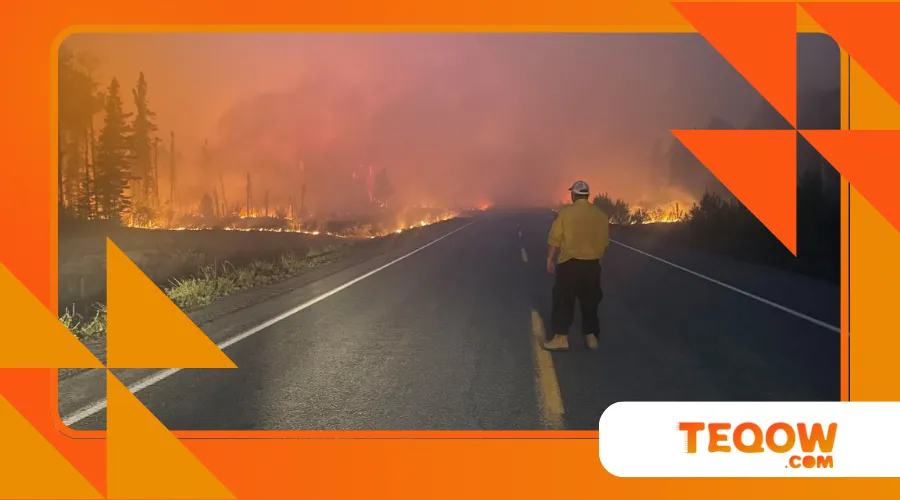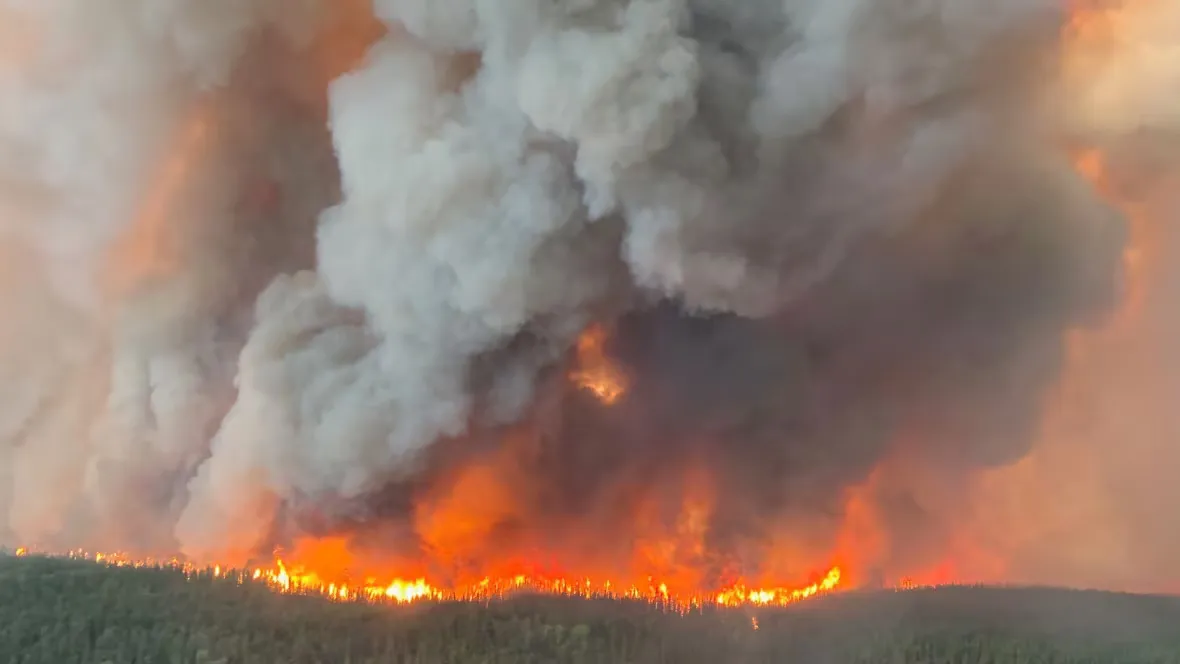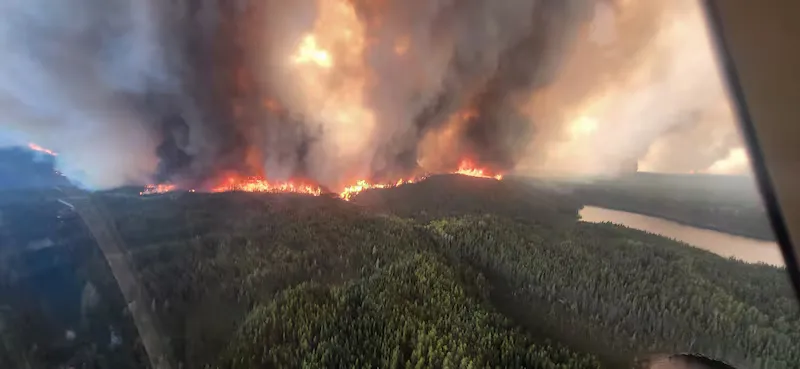17,000 Manitobans Flee as Out-of-Control Wildfires Threaten Communities

Out-of-control wildfires are forcing 17,000 Manitobans to flee their homes in what officials are calling the largest evacuation in the province’s living memory.
These blazes, driven by relentless winds and parched landscapes, have created a crisis that stretches far beyond Manitoba’s borders—sending smoke into the U.S. Midwest and exposing the vulnerabilities of communities, infrastructure, and emergency response systems.
A Crisis Unfolds: Manitoba’s Largest Evacuation
The scale of the current emergency is staggering.
Premier Wab Kinew declared a state of emergency as out-of-control wildfires swept through northern and eastern Manitoba, compelling entire communities—including First Nations, the city of Flin Flon, and rural towns—to evacuate.
The military has been deployed to assist, and Winnipeg has opened its doors to thousands of evacuees seeking shelter.
As one resident of Flin Flon described, “The town is absolutely smoked out… We’re just kind of in a panic here,” capturing the anxiety and urgency gripping the region.
In addition to the immediate challenges of evacuation, the psychological impact on residents cannot be understated.
Many are grappling with anxiety and uncertainty about their homes and futures, which adds to the emotional toll of such a large-scale crisis.
The Numbers Behind the Flames
Wildfire statistics reveal the magnitude of the threat.
As of late May 2025, Manitoba had recorded 102 wildfires—well above the 10-year average of 77 for this period.
Nationally, Canada is battling 158 active fires, with 83 categorized as “out of control.”
Over 1.58 million acres have burned across the country this year, a figure that is 40% higher than the decade’s average.
In Manitoba alone, 491,000 acres have already been scorched.
| Province | 2025 Wildfires | 10-Year Avg. | Area Burned (ha) | 10-Year Avg. (ha) |
|---|---|---|---|---|
| Manitoba | 143 | 60 | 167,635 | 42,827 |
| Alberta | 318 | 118 | 56,268 | 59,289 |
| Canada | 1,097 | 1,230 | 2,626,130 | 2,956,000 |
This alarming trend highlights the urgent need for improved wildfire management strategies and resources.
Organizations like the Canadian Interagency Forest Fire Centre provide vital data and support for wildfire prevention and response efforts across the country.
The Human Toll: Stories of Displacement
Beyond the numbers, the human impact is profound.
Thousands of First Nations residents have been forced to evacuate, sometimes with little notice and limited resources.
In Pimicikamak, the local airport was rendered unusable by fire, isolating the community and complicating evacuation efforts.
The emotional toll is evident: one resident described the surreal experience of seeing entire towns leave in convoys, a scene reminiscent of disaster movies but all too real for those living it.
Additionally, the displacement of families has led to increased strain on local shelters and resources, as communities rally to support those affected.
This solidarity, while heartening, also underscores the need for more robust emergency preparedness plans.
Climate Change: The Invisible Arsonist
Why are out-of-control wildfires becoming so frequent and severe?
The answer lies, in large part, with climate change.
Canada’s boreal forests have always experienced periodic fires, but rising temperatures and prolonged droughts have made conditions far more volatile.
The 2023 wildfire season was the most destructive in Canadian history, and 2025 is already shaping up to be another record-breaking year.
Overwintering “zombie” fires—blazes that smoulder underground through winter—have become more common, defying traditional seasonal boundaries.
Experts warn that without significant action on climate change, these patterns will only worsen.
Investing in sustainable practices and renewable energy sources can help mitigate future wildfire risks.
+ The impact of artificial intelligence on news coverage and content curation
Ripple Effects: Smoke, Health, and Infrastructure
The consequences of these wildfires extend far beyond the immediate burn zones.
Smoke from Manitoba’s fires is drifting south, degrading air quality in cities like Minneapolis, Milwaukee, and Chicago.
This transboundary pollution poses health risks for millions, especially those with respiratory conditions.
In 2023, Canadian wildfires caused unprecedented air pollution levels across North America—a scenario that may repeat this year.
Moreover, the economic impact of these health risks could be significant, with increased healthcare costs and lost productivity.
Communities must be proactive in addressing these challenges to protect public health and well-being.

Emergency Response: Coordination and Challenges
The sheer scale of the evacuation—17,000 people in days—has tested Manitoba’s emergency response capacity.
The military’s involvement has been crucial, enabling rapid relocations and logistical support.
Yet, the crisis has exposed vulnerabilities: limited evacuation routes, the threat to critical infrastructure, and the need for more resilient community planning.
For example, Flin Flon’s reliance on a single highway for evacuation highlights the risks of geographic isolation.
This situation calls for a comprehensive review of emergency response protocols to ensure better preparedness for future crises.
Strengthening community resilience through training and resources can make a significant difference in outcomes.
Indigenous Communities: At the Front Lines
First Nations are disproportionately affected by out-of-control wildfires.
Many live in remote regions with limited access to emergency services and infrastructure.
The evacuation of Pimicikamak, Pukatawagan, and other communities underscores the need for culturally sensitive disaster planning and long-term support.
As MKO Grand Chief Garrison Settee emphasized, “First Nations are not alone in this fight,” but they often bear the brunt of environmental crises.
Addressing these disparities requires collaboration between governments and Indigenous leaders to develop tailored strategies that respect cultural practices.
Empowering local communities can enhance their capacity to respond effectively to disasters.
Learning from the Past, Preparing for the Future
Canada’s wildfire crisis is not an isolated event—it is part of a global trend.
According to the Canadian Interagency Forest Fire Centre, 2023 saw over 42 million acres burned nationwide, more than double the previous record.
This pattern mirrors wildfire surges in Australia, California, and the Mediterranean, all linked to shifting climate patterns and land management practices.
| Year | Total Area Burned (Canada, ha) | Number of Wildfires |
|---|---|---|
| 2023 | 17,300,000 | 7,131 |
| 2024 | 5,300,000 | 5,000 |
| 2025 | 1,580,000 (to date) | 1,097 (to date) |
To combat this trend, Canada must invest in innovative land management techniques and prioritize fire prevention measures.
Learning from successful strategies implemented in other countries can provide valuable insights for improving resilience against future wildfires.
Analogies and Insights: Wildfires as a Test of Resilience
Imagine a community as a living organism—when fire strikes, it’s like a sudden, severe infection.
The health of the organism depends on how quickly it can respond, adapt, and recover.
Manitoba’s experience is a test of resilience: how well can its people, infrastructure, and ecosystems withstand and rebound from repeated shocks?
This analogy highlights the importance of fostering a culture of preparedness and adaptability within communities.
Building strong social networks and support systems can enhance resilience and facilitate recovery.

Two Original Examples
- In 2021, the small town of Lytton, British Columbia, was almost entirely destroyed by wildfire within hours.
The rapid loss of homes, businesses, and cultural landmarks left residents traumatized and highlighted the need for faster emergency alerts and more robust rebuilding plans.
- In northern Alberta, a community-led fireguard project in 2022 successfully protected a remote village by combining traditional Indigenous knowledge with modern firefighting techniques, demonstrating that local engagement can make a critical difference.
These examples illustrate the diverse approaches communities can take to enhance their wildfire resilience.
Sharing best practices and lessons learned can empower other regions facing similar threats.
++ Canada’s Green Energy Transition: Innovations and Challenges in Meeting 2030 Climate Targets
What’s Next? Rethinking Policy and Prevention
As wildfires become more frequent and intense, how can Canada adapt?
This is not just a question for policymakers, but for every resident in fire-prone regions.
Should communities invest more in prescribed burns, fire-resistant infrastructure, or early warning systems?
Are evacuation plans robust enough for future crises?
Engaging the public in discussions about wildfire preparedness can lead to more informed and effective policies.
Community workshops and educational programs can empower residents to take proactive steps in safeguarding their homes.
A Call to Action: Building a Fire-Resilient Future
The current wave of out-of-control wildfires is a wake-up call, demanding urgent action on multiple fronts.
Governments must invest in prevention, response, and recovery.
Communities need support to rebuild and adapt.
And individuals must be prepared to respond quickly when the next emergency strikes.
As Premier Kinew said, “We will overcome this challenging time together, as we always do.”
Collective action and collaboration will be essential in fostering a culture of resilience and preparedness.
By working together, communities can build a stronger foundation for facing future challenges.
Conclusion
Out-of-control wildfires are not just a natural disaster—they are a test of our collective resilience, adaptability, and compassion.
The evacuation of 17,000 Manitobans is a stark reminder that climate change is not a distant threat, but a present reality.
By learning from this crisis and investing in smarter, more inclusive solutions, Canada can lead the way in building a safer, more sustainable future.
Key Statistics:
- 17,000 Manitobans evacuated—the largest in provincial history.
- 102 wildfires in Manitoba this year, far above the 10-year average.
- Over 1.58 million acres burned in Canada in 2025, 40% above average.
Reference: Canadian Interagency Forest Fire Centre (CIFFC) data, May 2025.
Tables
| Province | 2025 Wildfires | 10-Year Avg. | Area Burned (ha) | 10-Year Avg. (ha) |
|---|---|---|---|---|
| Manitoba | 143 | 60 | 167,635 | 42,827 |
| Alberta | 318 | 118 | 56,268 | 59,289 |
| Canada | 1,097 | 1,230 | 2,626,130 | 2,956,000 |
| Year | Total Area Burned (Canada, ha) | Number of Wildfires |
|---|---|---|
| 2023 | 17,300,000 | 7,131 |
| 2024 | 5,300,000 | 5,000 |
| 2025 | 1,580,000 (to date) | 1,097 (to date) |
Will the lessons of 2025 spark a new era of wildfire resilience, or will history repeat itself as the climate crisis deepens?
The answer depends on the choices we make—today.
